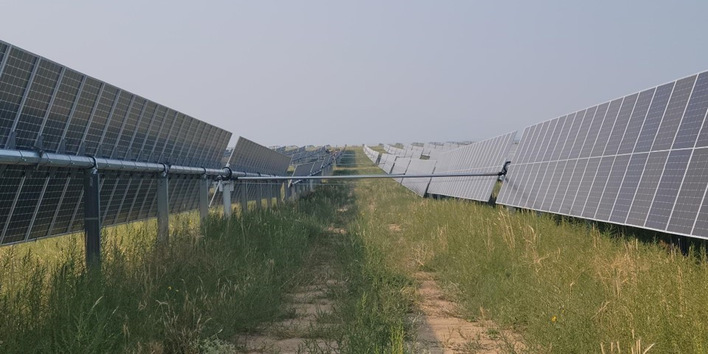Good news from Switzerland: In autumn 2022, with the "urgent federal law on the short-term provision of a secure electricity supply in winter", the Swiss parliament created the conditions for a rapid expansion of ground-mounted solar plants in the mountains. The eligibility for a simplified approval procedure and additional subsidies is thus valid until the end of 2025 or up to a total annual production of two terawatt hours. With the new federal law, Parliament is providing a welcome short-term boost for alpine solar power plants.
Meeting the demand of 300,000 households
Axpo immediately takes up this positive signal and wants to build solar plants with an output of more than 1.2 gigawatts in the Alps and on the Swiss Plateau by 2030. This would be enough to meet the annual demand of more than 300,000 households. "Improved political framework conditions, which make such investments possible in the first place, together with the higher market prices for electricity, make this offensive possible," explains Axpo CEO Christoph Brand. The new target represents a six-fold increase in previous ambitions: from 200 megawatts to more than 1.2 gigawatts by 2030. This corresponds to an annual production of around 1.5 billion kilowatt hours or the annual consumption of more than 300,000 households in Switzerland. Axpo expects to invest around 1.5 billion Swiss francs in the expansion.

Axpo
Focus remains on environmental compatibility
The solar expansion of around 600 megawatts in the Alps always involves weighing up the need for a secure electricity supply with sufficient capacity against the impact on the environment, explains Andelko Suker, who heads the solar power plant department in the Axpo Group. Axpo has set itself the target of continuing to show the greatest possible consideration for nature and the landscape. It is also clear that solar power plants will not be permitted everywhere in the future. "For example, not in habitats of national importance or in bird reserves," explains Suker. An environmental impact assessment would still be necessary.
The solar offensive includes, on the one hand, alpine solar plants mounted to infrastructure and ground-mounted solar plants, and, on the other hand, projects in the Swiss Plateau. The power plans are being implemented by Axpo subsidiary CKW. Together with its parent company, it is already installing more than two solar plants on buildings every day. CKW is drawing on the extensive experience and economies of scale of Axpo's French subsidiary Urbasolar, which has been building large-scale solar power plants internationally for many years.
Compulsory solar roofs for new buildings
Axpo will not only build large open-space plants, however, but will also push new solar projects in residential areas. This is because in the autumn the Swiss Government also passed a new solar roof obligation for new buildings with a floor area of more than 300 square metres. Axpo and CKW are planning to add 600 roof-mounted systems per year, which will be realised by CKW-Gebäudetechnik, reports project manager Suker.

ZHAW
The solar offensive makes a valuable contribution to the electricity supply, especially in winter. Positive experiences have already been made: Axpo and IWB have built Switzerland's largest alpine solar plant to date at an altitude of 2,500 metres at Muttsee in the canton of Glarus. The plant has been fully operational since the end of August 2022. It generates 3.3 million kilowatt hours of electricity per year - half of it in winter.
Alpinsolar supplied a lot of know-how
The data confirms that alpine solar plants above the sea of fog deliver around three times as much electricity in winter as comparable plants on the Swiss Plateau. This electricity is particularly valuable in view of the growing winter gap. Experience from Lake Muttsee since the partial commissioning in October 2021 shows that winter electricity can be realised on the scale envisaged. "The plant has not only fulfilled our expectations. We have also gained a lot of know-how during the realisation, which we can use for the coming projects," says Suker.
Ten megawatts at the Nalps reservoir
The next project in the Alps is already well underway. The ground-mounted Nalpsolar plant with ten megawatts is now to be built next to the Nalps reservoir in the canton of Graubünden. Construction is expected to start in spring 2024, and commissioning is planned for autumn 2025.
The project was also unanimously supported by the Tujetsch municipal council. "According to the feasibility study, the location of the alpine solar plant right next to the reservoir is ideal. If the environmental impact assessment is also positive, the population will fully support the project," says Martin Cavegn, chairman of the municipality. On the one hand, the project creates local added value for the municipality, and on the other, it contributes to the development of green energy.
Nalpsolar is the size of twelve football pitches
In the planned solar park, 30,000 modules will be installed on an open area of about eight hectares. By way of comparison, this is roughly equivalent to an area of twelve football pitches. The plant is adjacent to the Lai da Nalps reservoir. "The infrastructure is already in place because of the hydroelectric power plant, so the impact on the landscape is very limited and concentrated," explains Suker.
See also: Axpo to market base load electricity from German PV plant
The new solar park at an altitude of around 2,000 metres is also expected to supply three times as much electricity in winter as a comparable installation in a residential area. This is due, on the one hand, to the higher solar radiation due to the thinner atmosphere. On the other hand, the snow reflects the sunlight. This is known in the trade as the albedo effect. Last but not least, the efficiency of the modules increases because they are cooled by lower temperatures. The electricity is supplied by bifacial modules, which use the solar radiation from both sides - and therefore also supply more electricity than conventional ones. The solar panels are installed on a steel construction a good two metres above the ground and at an angle of 75 degrees. This allows the snow to slide off more easily and keeps the modules free of snow.

Axpo
Land sought for further projects
Axpo expects alpine solar plants to become economically viable over their entire service life of around 25 years. They pay for themselves, for example, through long-term purchase agreements (PPAs). The contractually secured average price protects electricity consumers against future price increases. Not altogether insignificant in these times. More ground-mounted plants are soon to be built in the mountains. Axpo is therefore also on the lookout for other land. Staff are talking to landowners and municipalities about this.
Policymakers have now provided the first impetus for winter electricity. "In the medium to long term, we need more sustainable framework conditions for the expansion of renewable electricity generation," Suker emphasises. Large solar power plants can now in principle be approved outside the building zone. "It would be better if possibilities were created so that alpine and other ground-mounted power plants could be approved as part of regular procedures," explains the expert. "We would then no longer have to rely on individual approval." In addition, he says, it would have to be ensured that such projects were also economically viable. And this requires an appropriate funding framework.
Expansion of solar power generation needs secure framework conditions
However, sustainable framework conditions for the expansion of green electricity generation remain important - even after 2025. For example, a follow-up solution to the urgent federal law is needed for ground-mounted solar power plants. In principle, however, the framework conditions for all renewable energies should be improved in the course of the overarching ordinance.
This would significantly increase the expansion of domestic electricity capacities. In this regard, the licensing procedures in particular should be simplified and accelerated. After all, by 2050 Switzerland will have a shortfall of around 50 terawatt hours of electricity per year. The Axpo model envisages a mix of different production technologies and a fundamental openness to technology to meet this enormous challenge. Solar energy already has a strong role in this mix.








